Analysis of Aerodynamic Drag Reduction and Vehicle Performance
VerifiedAdded on 2023/04/25
|19
|4424
|196
Report
AI Summary
This report delves into the principles of aerodynamic drag and its impact on vehicle performance. It explores various methods to reduce drag, including the use of vortex generators, diffusers, and rear fairing (fastback) designs. The report explains how these techniques, along with streamlining, can improve fuel efficiency, increase acceleration, and enhance the overall handling of vehicles. Furthermore, the report discusses the importance of downforce, particularly in racing cars, and the concept of the coefficient of drag (Cd) in relation to vehicle aerodynamics. The study also covers external and internal aerodynamics and their influence on the forces acting upon a moving vehicle. The study of aerodynamics is related to the interactions of the particles of air with the other objects that are in motion. The report also explores the use of vortex generators which increase the angle of attack, improve stall characteristics and stability at lower speeds. Diffusers are discussed as a means to improve the transition between the high-velocity airflow under the car and the slower freestream airflow, reducing pressure drag. Finally, the fastback design is presented as a method to achieve low drag coefficients through the presence of an attached boundary layer.

RESEARCH DESIGN AND METHODS
By Name
Course
Instructor
Institution
Location
Date
By Name
Course
Instructor
Institution
Location
Date
Paraphrase This Document
Need a fresh take? Get an instant paraphrase of this document with our AI Paraphraser
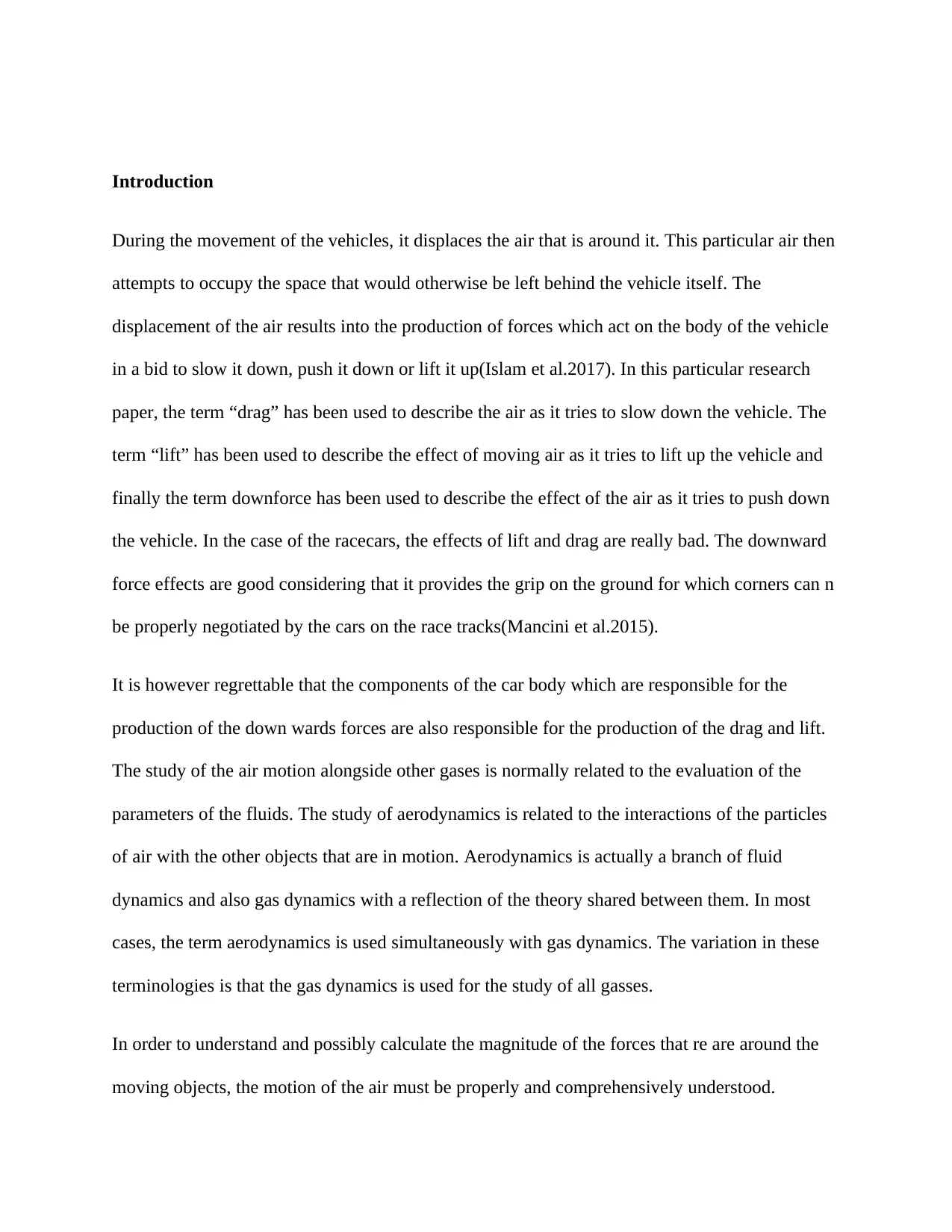
Introduction
During the movement of the vehicles, it displaces the air that is around it. This particular air then
attempts to occupy the space that would otherwise be left behind the vehicle itself. The
displacement of the air results into the production of forces which act on the body of the vehicle
in a bid to slow it down, push it down or lift it up(Islam et al.2017). In this particular research
paper, the term “drag” has been used to describe the air as it tries to slow down the vehicle. The
term “lift” has been used to describe the effect of moving air as it tries to lift up the vehicle and
finally the term downforce has been used to describe the effect of the air as it tries to push down
the vehicle. In the case of the racecars, the effects of lift and drag are really bad. The downward
force effects are good considering that it provides the grip on the ground for which corners can n
be properly negotiated by the cars on the race tracks(Mancini et al.2015).
It is however regrettable that the components of the car body which are responsible for the
production of the down wards forces are also responsible for the production of the drag and lift.
The study of the air motion alongside other gases is normally related to the evaluation of the
parameters of the fluids. The study of aerodynamics is related to the interactions of the particles
of air with the other objects that are in motion. Aerodynamics is actually a branch of fluid
dynamics and also gas dynamics with a reflection of the theory shared between them. In most
cases, the term aerodynamics is used simultaneously with gas dynamics. The variation in these
terminologies is that the gas dynamics is used for the study of all gasses.
In order to understand and possibly calculate the magnitude of the forces that re are around the
moving objects, the motion of the air must be properly and comprehensively understood.
During the movement of the vehicles, it displaces the air that is around it. This particular air then
attempts to occupy the space that would otherwise be left behind the vehicle itself. The
displacement of the air results into the production of forces which act on the body of the vehicle
in a bid to slow it down, push it down or lift it up(Islam et al.2017). In this particular research
paper, the term “drag” has been used to describe the air as it tries to slow down the vehicle. The
term “lift” has been used to describe the effect of moving air as it tries to lift up the vehicle and
finally the term downforce has been used to describe the effect of the air as it tries to push down
the vehicle. In the case of the racecars, the effects of lift and drag are really bad. The downward
force effects are good considering that it provides the grip on the ground for which corners can n
be properly negotiated by the cars on the race tracks(Mancini et al.2015).
It is however regrettable that the components of the car body which are responsible for the
production of the down wards forces are also responsible for the production of the drag and lift.
The study of the air motion alongside other gases is normally related to the evaluation of the
parameters of the fluids. The study of aerodynamics is related to the interactions of the particles
of air with the other objects that are in motion. Aerodynamics is actually a branch of fluid
dynamics and also gas dynamics with a reflection of the theory shared between them. In most
cases, the term aerodynamics is used simultaneously with gas dynamics. The variation in these
terminologies is that the gas dynamics is used for the study of all gasses.
In order to understand and possibly calculate the magnitude of the forces that re are around the
moving objects, the motion of the air must be properly and comprehensively understood.
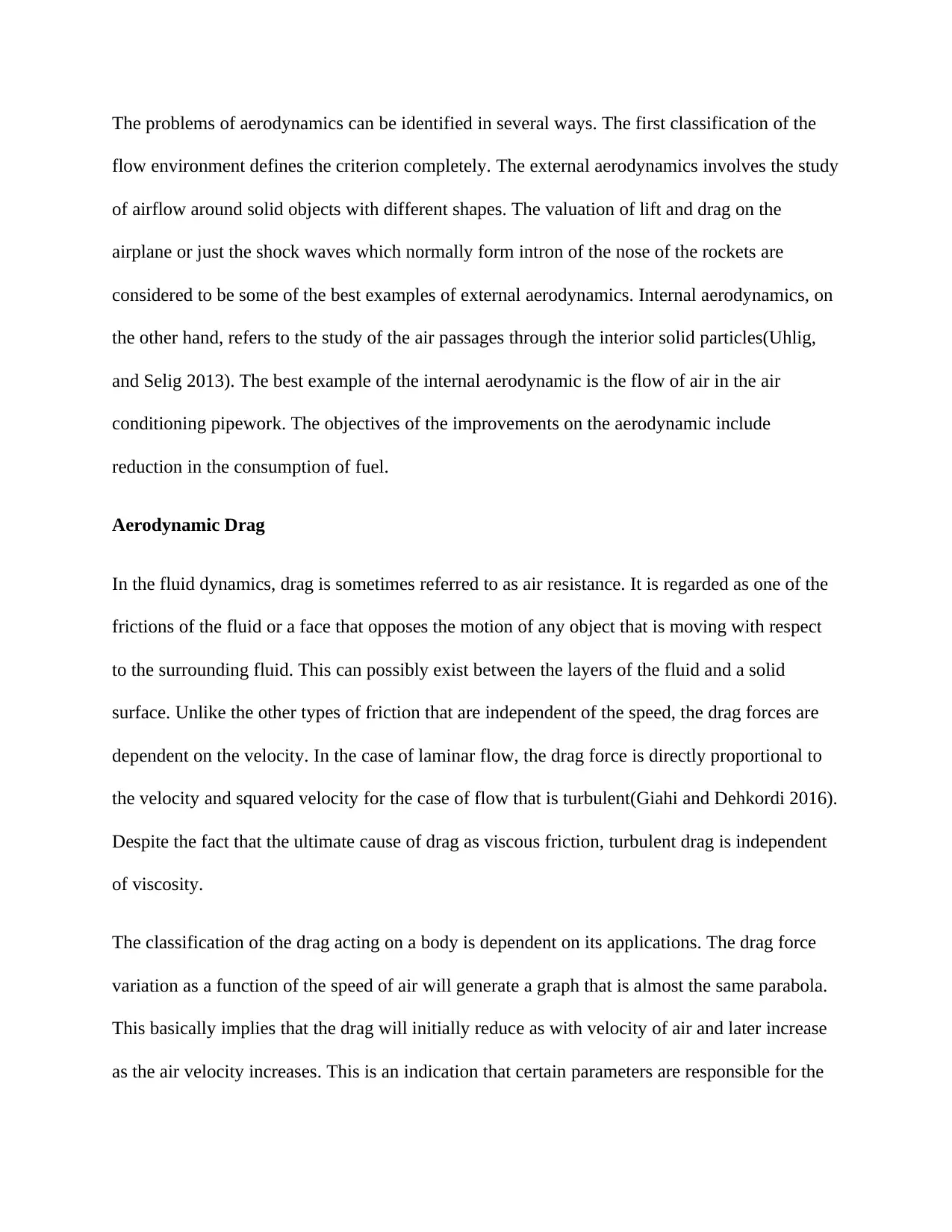
The problems of aerodynamics can be identified in several ways. The first classification of the
flow environment defines the criterion completely. The external aerodynamics involves the study
of airflow around solid objects with different shapes. The valuation of lift and drag on the
airplane or just the shock waves which normally form intron of the nose of the rockets are
considered to be some of the best examples of external aerodynamics. Internal aerodynamics, on
the other hand, refers to the study of the air passages through the interior solid particles(Uhlig,
and Selig 2013). The best example of the internal aerodynamic is the flow of air in the air
conditioning pipework. The objectives of the improvements on the aerodynamic include
reduction in the consumption of fuel.
Aerodynamic Drag
In the fluid dynamics, drag is sometimes referred to as air resistance. It is regarded as one of the
frictions of the fluid or a face that opposes the motion of any object that is moving with respect
to the surrounding fluid. This can possibly exist between the layers of the fluid and a solid
surface. Unlike the other types of friction that are independent of the speed, the drag forces are
dependent on the velocity. In the case of laminar flow, the drag force is directly proportional to
the velocity and squared velocity for the case of flow that is turbulent(Giahi and Dehkordi 2016).
Despite the fact that the ultimate cause of drag as viscous friction, turbulent drag is independent
of viscosity.
The classification of the drag acting on a body is dependent on its applications. The drag force
variation as a function of the speed of air will generate a graph that is almost the same parabola.
This basically implies that the drag will initially reduce as with velocity of air and later increase
as the air velocity increases. This is an indication that certain parameters are responsible for the
flow environment defines the criterion completely. The external aerodynamics involves the study
of airflow around solid objects with different shapes. The valuation of lift and drag on the
airplane or just the shock waves which normally form intron of the nose of the rockets are
considered to be some of the best examples of external aerodynamics. Internal aerodynamics, on
the other hand, refers to the study of the air passages through the interior solid particles(Uhlig,
and Selig 2013). The best example of the internal aerodynamic is the flow of air in the air
conditioning pipework. The objectives of the improvements on the aerodynamic include
reduction in the consumption of fuel.
Aerodynamic Drag
In the fluid dynamics, drag is sometimes referred to as air resistance. It is regarded as one of the
frictions of the fluid or a face that opposes the motion of any object that is moving with respect
to the surrounding fluid. This can possibly exist between the layers of the fluid and a solid
surface. Unlike the other types of friction that are independent of the speed, the drag forces are
dependent on the velocity. In the case of laminar flow, the drag force is directly proportional to
the velocity and squared velocity for the case of flow that is turbulent(Giahi and Dehkordi 2016).
Despite the fact that the ultimate cause of drag as viscous friction, turbulent drag is independent
of viscosity.
The classification of the drag acting on a body is dependent on its applications. The drag force
variation as a function of the speed of air will generate a graph that is almost the same parabola.
This basically implies that the drag will initially reduce as with velocity of air and later increase
as the air velocity increases. This is an indication that certain parameters are responsible for the
⊘ This is a preview!⊘
Do you want full access?
Subscribe today to unlock all pages.

Trusted by 1+ million students worldwide
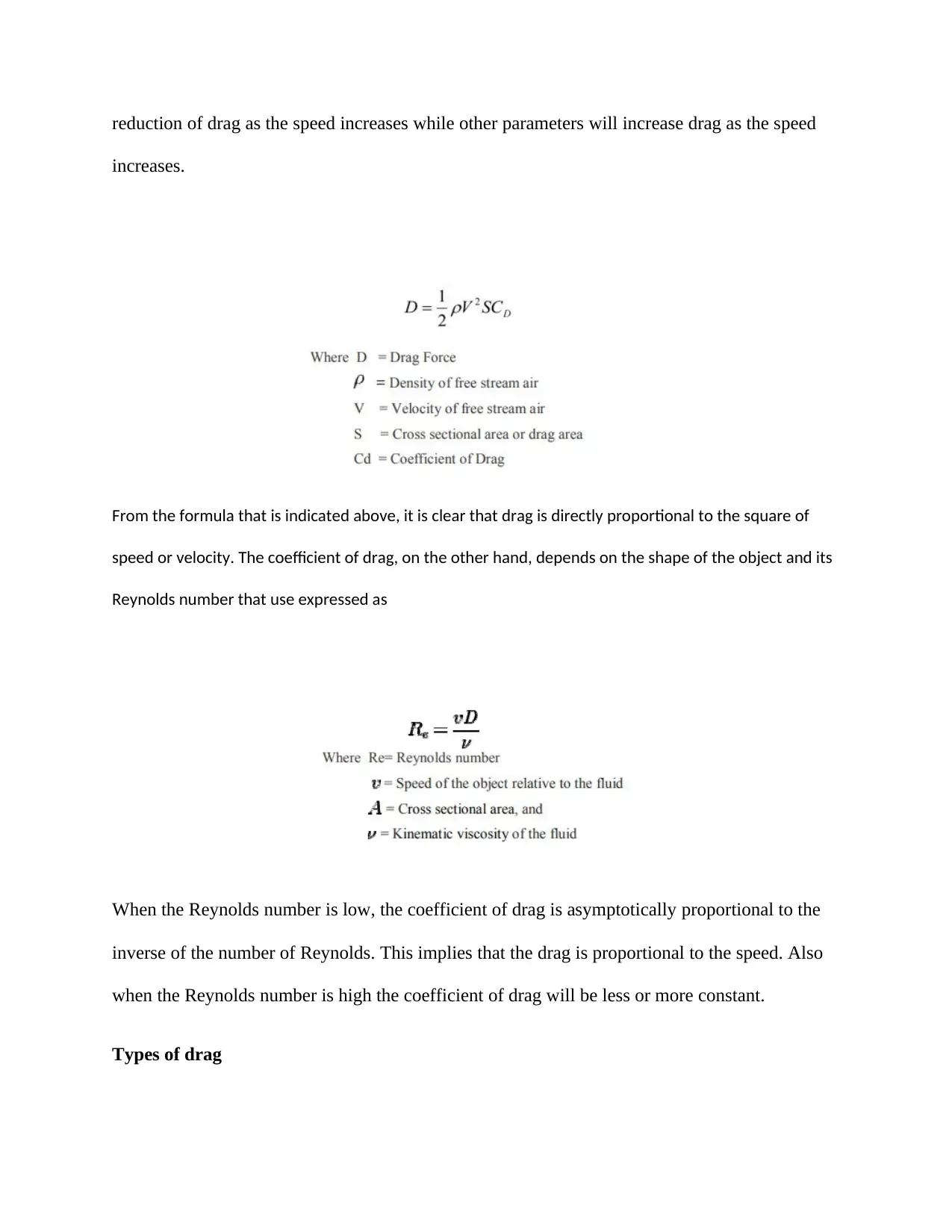
reduction of drag as the speed increases while other parameters will increase drag as the speed
increases.
From the formula that is indicated above, it is clear that drag is directly proportional to the square of
speed or velocity. The coefficient of drag, on the other hand, depends on the shape of the object and its
Reynolds number that use expressed as
When the Reynolds number is low, the coefficient of drag is asymptotically proportional to the
inverse of the number of Reynolds. This implies that the drag is proportional to the speed. Also
when the Reynolds number is high the coefficient of drag will be less or more constant.
Types of drag
increases.
From the formula that is indicated above, it is clear that drag is directly proportional to the square of
speed or velocity. The coefficient of drag, on the other hand, depends on the shape of the object and its
Reynolds number that use expressed as
When the Reynolds number is low, the coefficient of drag is asymptotically proportional to the
inverse of the number of Reynolds. This implies that the drag is proportional to the speed. Also
when the Reynolds number is high the coefficient of drag will be less or more constant.
Types of drag
Paraphrase This Document
Need a fresh take? Get an instant paraphrase of this document with our AI Paraphraser
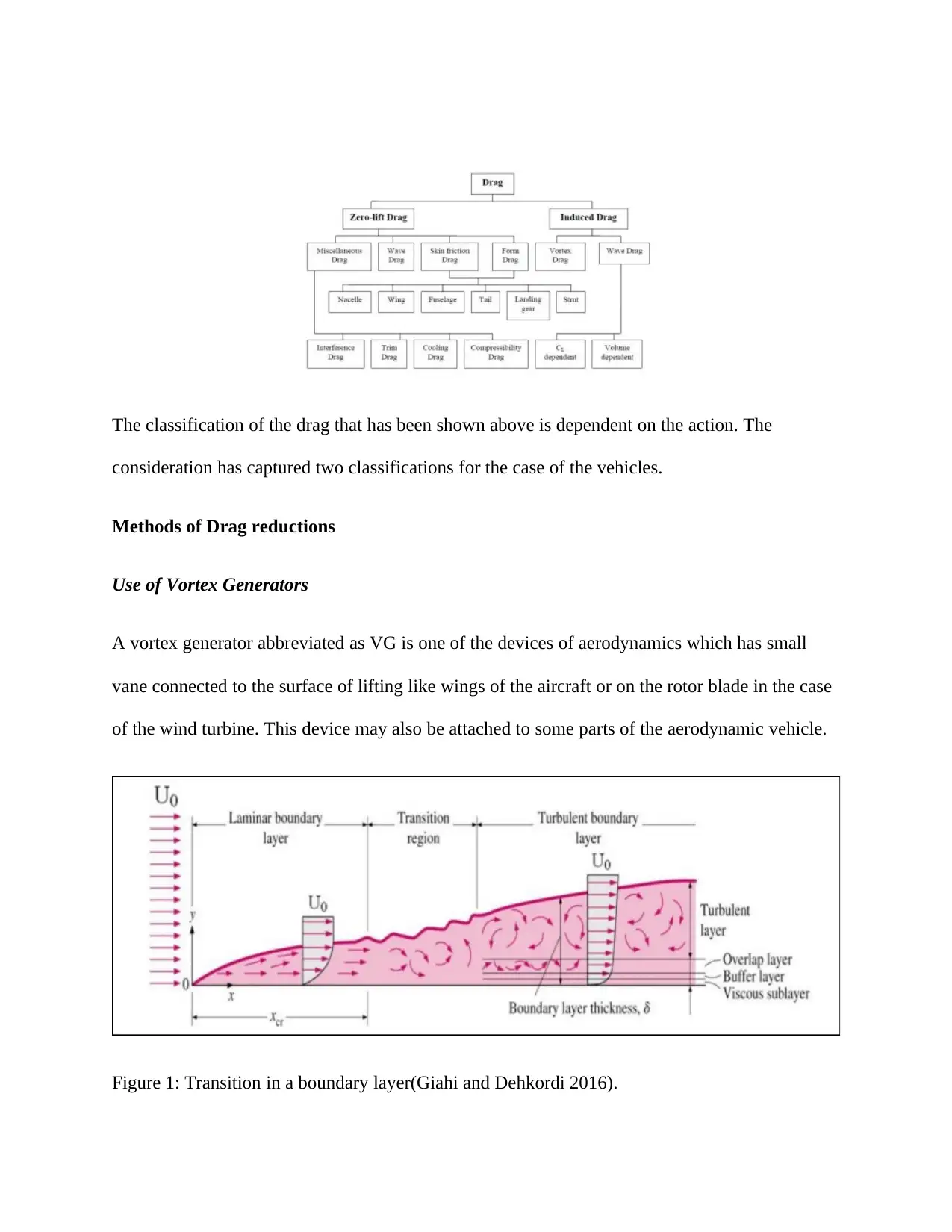
The classification of the drag that has been shown above is dependent on the action. The
consideration has captured two classifications for the case of the vehicles.
Methods of Drag reductions
Use of Vortex Generators
A vortex generator abbreviated as VG is one of the devices of aerodynamics which has small
vane connected to the surface of lifting like wings of the aircraft or on the rotor blade in the case
of the wind turbine. This device may also be attached to some parts of the aerodynamic vehicle.
Figure 1: Transition in a boundary layer(Giahi and Dehkordi 2016).
consideration has captured two classifications for the case of the vehicles.
Methods of Drag reductions
Use of Vortex Generators
A vortex generator abbreviated as VG is one of the devices of aerodynamics which has small
vane connected to the surface of lifting like wings of the aircraft or on the rotor blade in the case
of the wind turbine. This device may also be attached to some parts of the aerodynamic vehicle.
Figure 1: Transition in a boundary layer(Giahi and Dehkordi 2016).
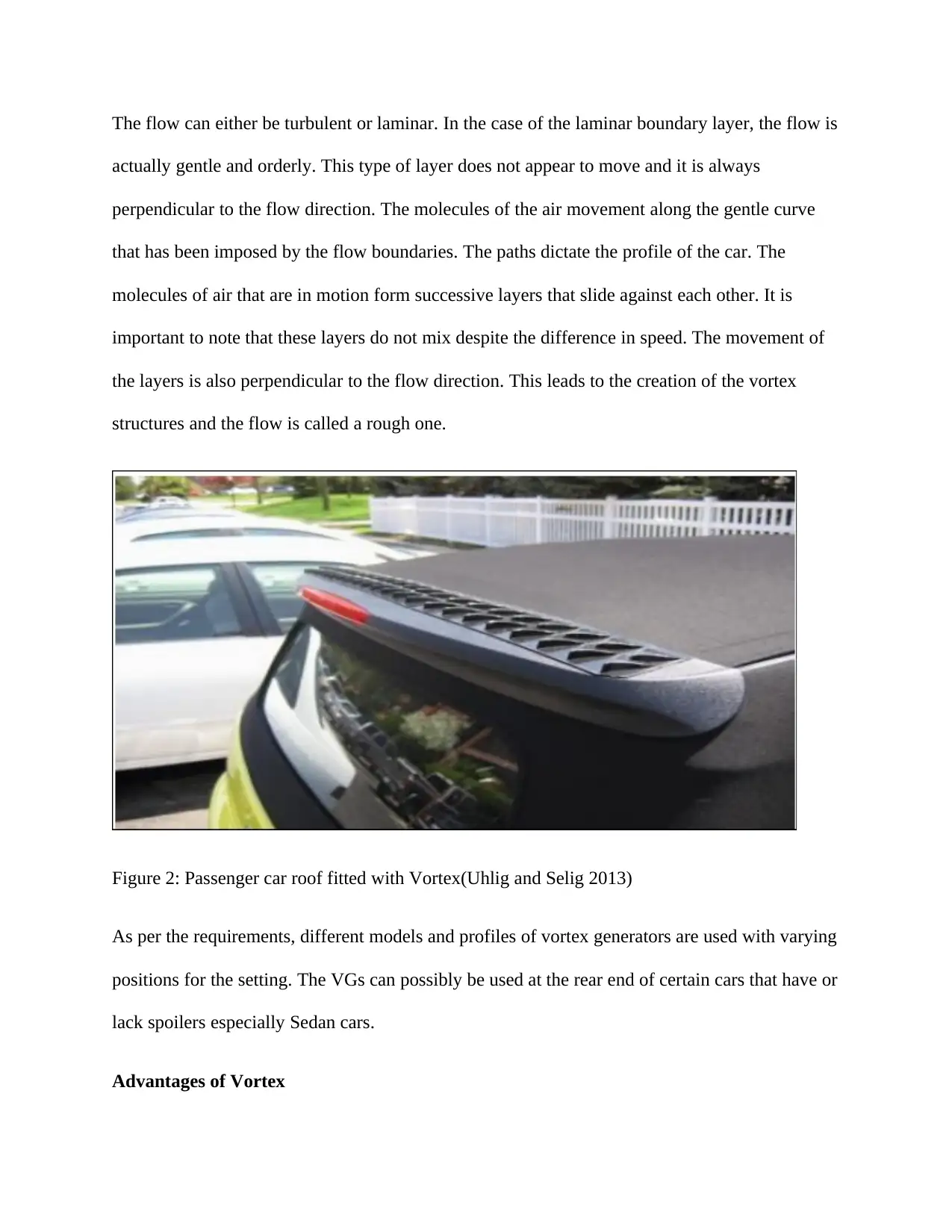
The flow can either be turbulent or laminar. In the case of the laminar boundary layer, the flow is
actually gentle and orderly. This type of layer does not appear to move and it is always
perpendicular to the flow direction. The molecules of the air movement along the gentle curve
that has been imposed by the flow boundaries. The paths dictate the profile of the car. The
molecules of air that are in motion form successive layers that slide against each other. It is
important to note that these layers do not mix despite the difference in speed. The movement of
the layers is also perpendicular to the flow direction. This leads to the creation of the vortex
structures and the flow is called a rough one.
Figure 2: Passenger car roof fitted with Vortex(Uhlig and Selig 2013)
As per the requirements, different models and profiles of vortex generators are used with varying
positions for the setting. The VGs can possibly be used at the rear end of certain cars that have or
lack spoilers especially Sedan cars.
Advantages of Vortex
actually gentle and orderly. This type of layer does not appear to move and it is always
perpendicular to the flow direction. The molecules of the air movement along the gentle curve
that has been imposed by the flow boundaries. The paths dictate the profile of the car. The
molecules of air that are in motion form successive layers that slide against each other. It is
important to note that these layers do not mix despite the difference in speed. The movement of
the layers is also perpendicular to the flow direction. This leads to the creation of the vortex
structures and the flow is called a rough one.
Figure 2: Passenger car roof fitted with Vortex(Uhlig and Selig 2013)
As per the requirements, different models and profiles of vortex generators are used with varying
positions for the setting. The VGs can possibly be used at the rear end of certain cars that have or
lack spoilers especially Sedan cars.
Advantages of Vortex
⊘ This is a preview!⊘
Do you want full access?
Subscribe today to unlock all pages.

Trusted by 1+ million students worldwide
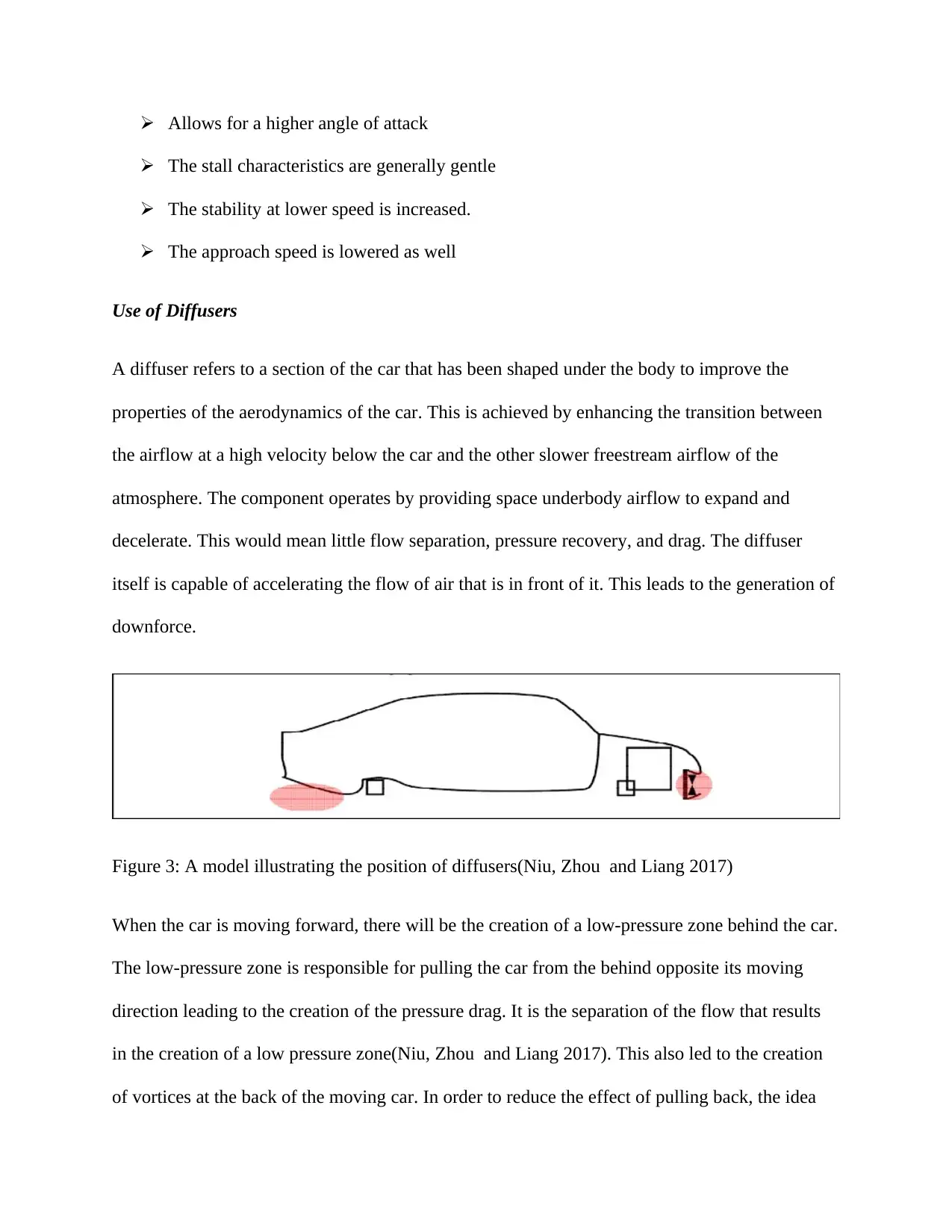
Allows for a higher angle of attack
The stall characteristics are generally gentle
The stability at lower speed is increased.
The approach speed is lowered as well
Use of Diffusers
A diffuser refers to a section of the car that has been shaped under the body to improve the
properties of the aerodynamics of the car. This is achieved by enhancing the transition between
the airflow at a high velocity below the car and the other slower freestream airflow of the
atmosphere. The component operates by providing space underbody airflow to expand and
decelerate. This would mean little flow separation, pressure recovery, and drag. The diffuser
itself is capable of accelerating the flow of air that is in front of it. This leads to the generation of
downforce.
Figure 3: A model illustrating the position of diffusers(Niu, Zhou and Liang 2017)
When the car is moving forward, there will be the creation of a low-pressure zone behind the car.
The low-pressure zone is responsible for pulling the car from the behind opposite its moving
direction leading to the creation of the pressure drag. It is the separation of the flow that results
in the creation of a low pressure zone(Niu, Zhou and Liang 2017). This also led to the creation
of vortices at the back of the moving car. In order to reduce the effect of pulling back, the idea
The stall characteristics are generally gentle
The stability at lower speed is increased.
The approach speed is lowered as well
Use of Diffusers
A diffuser refers to a section of the car that has been shaped under the body to improve the
properties of the aerodynamics of the car. This is achieved by enhancing the transition between
the airflow at a high velocity below the car and the other slower freestream airflow of the
atmosphere. The component operates by providing space underbody airflow to expand and
decelerate. This would mean little flow separation, pressure recovery, and drag. The diffuser
itself is capable of accelerating the flow of air that is in front of it. This leads to the generation of
downforce.
Figure 3: A model illustrating the position of diffusers(Niu, Zhou and Liang 2017)
When the car is moving forward, there will be the creation of a low-pressure zone behind the car.
The low-pressure zone is responsible for pulling the car from the behind opposite its moving
direction leading to the creation of the pressure drag. It is the separation of the flow that results
in the creation of a low pressure zone(Niu, Zhou and Liang 2017). This also led to the creation
of vortices at the back of the moving car. In order to reduce the effect of pulling back, the idea
Paraphrase This Document
Need a fresh take? Get an instant paraphrase of this document with our AI Paraphraser
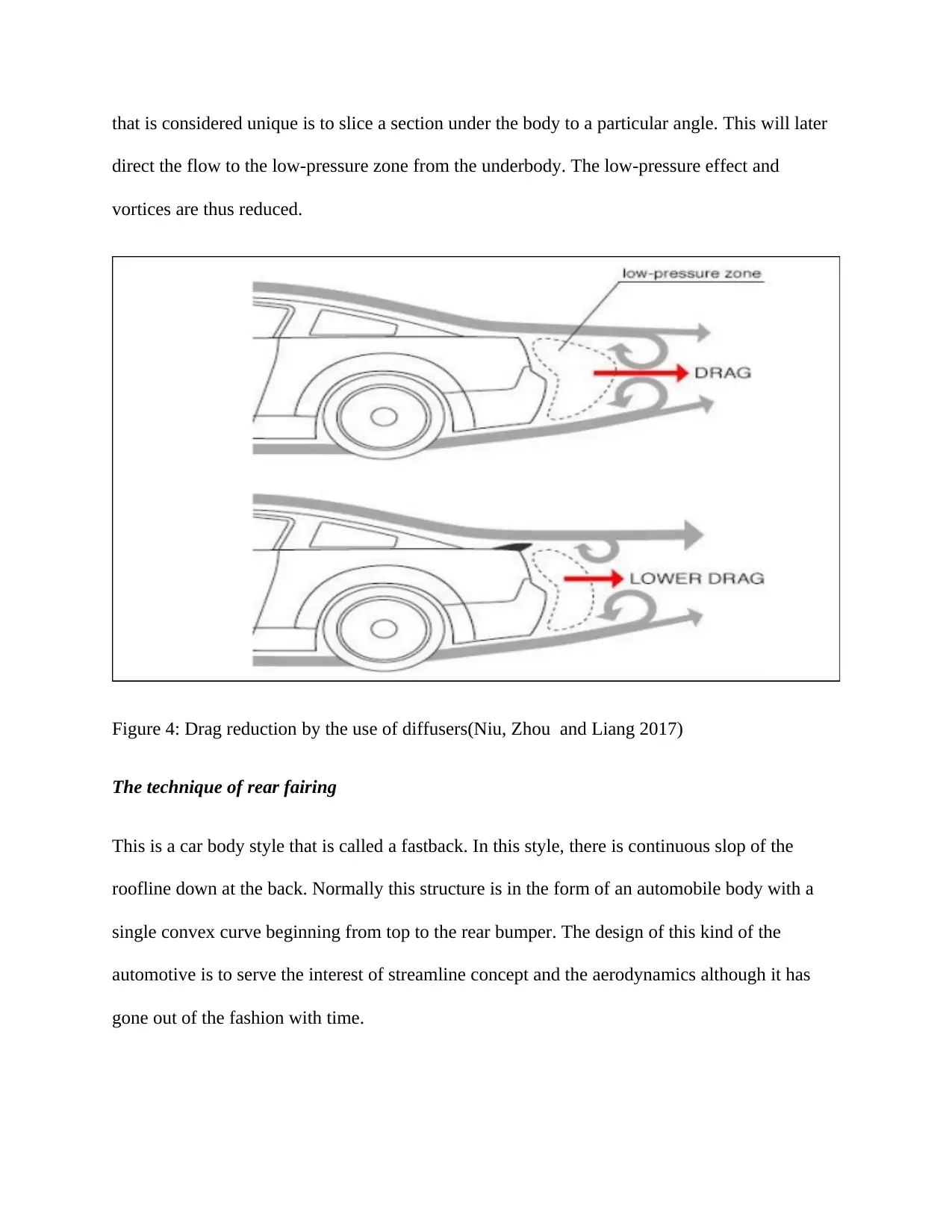
that is considered unique is to slice a section under the body to a particular angle. This will later
direct the flow to the low-pressure zone from the underbody. The low-pressure effect and
vortices are thus reduced.
Figure 4: Drag reduction by the use of diffusers(Niu, Zhou and Liang 2017)
The technique of rear fairing
This is a car body style that is called a fastback. In this style, there is continuous slop of the
roofline down at the back. Normally this structure is in the form of an automobile body with a
single convex curve beginning from top to the rear bumper. The design of this kind of the
automotive is to serve the interest of streamline concept and the aerodynamics although it has
gone out of the fashion with time.
direct the flow to the low-pressure zone from the underbody. The low-pressure effect and
vortices are thus reduced.
Figure 4: Drag reduction by the use of diffusers(Niu, Zhou and Liang 2017)
The technique of rear fairing
This is a car body style that is called a fastback. In this style, there is continuous slop of the
roofline down at the back. Normally this structure is in the form of an automobile body with a
single convex curve beginning from top to the rear bumper. The design of this kind of the
automotive is to serve the interest of streamline concept and the aerodynamics although it has
gone out of the fashion with time.
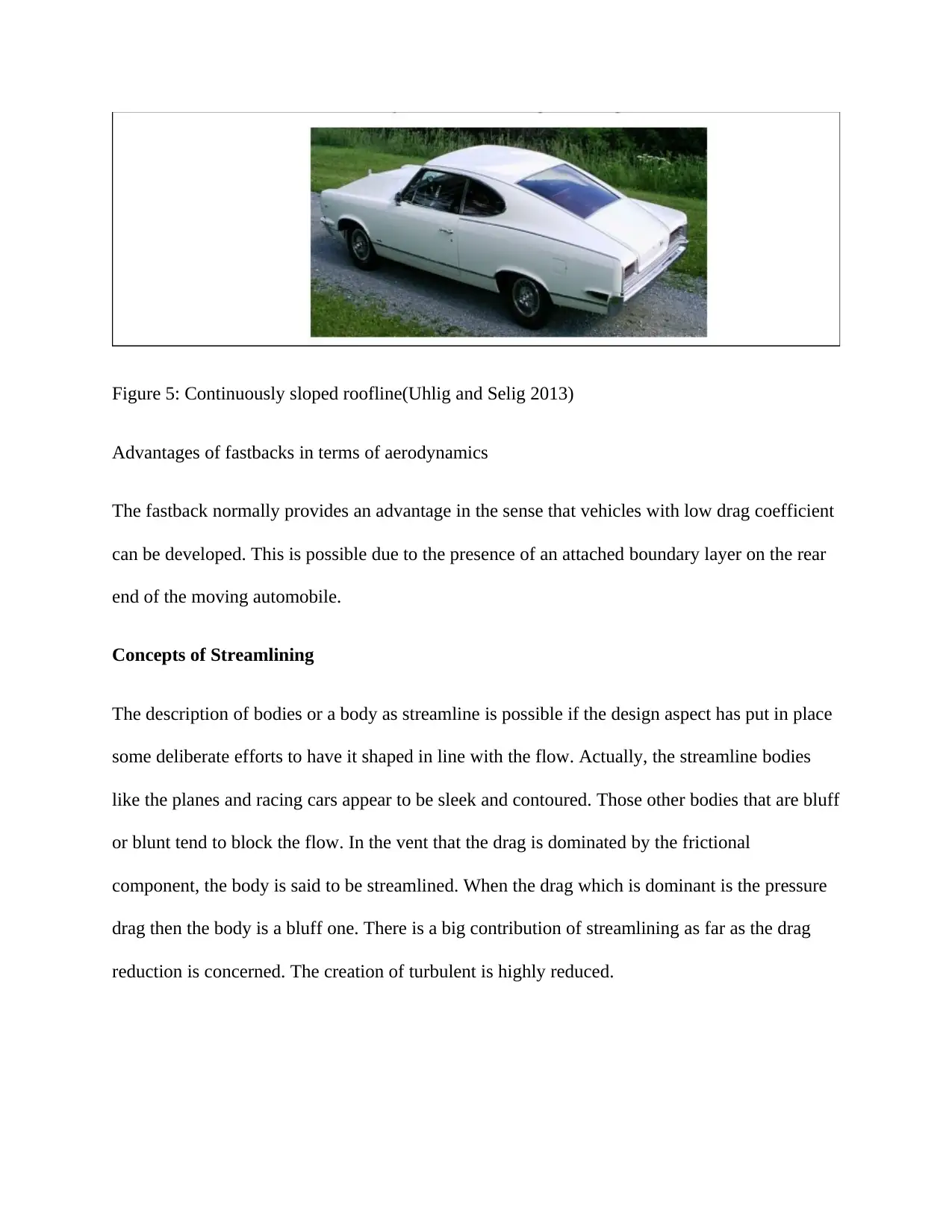
Figure 5: Continuously sloped roofline(Uhlig and Selig 2013)
Advantages of fastbacks in terms of aerodynamics
The fastback normally provides an advantage in the sense that vehicles with low drag coefficient
can be developed. This is possible due to the presence of an attached boundary layer on the rear
end of the moving automobile.
Concepts of Streamlining
The description of bodies or a body as streamline is possible if the design aspect has put in place
some deliberate efforts to have it shaped in line with the flow. Actually, the streamline bodies
like the planes and racing cars appear to be sleek and contoured. Those other bodies that are bluff
or blunt tend to block the flow. In the vent that the drag is dominated by the frictional
component, the body is said to be streamlined. When the drag which is dominant is the pressure
drag then the body is a bluff one. There is a big contribution of streamlining as far as the drag
reduction is concerned. The creation of turbulent is highly reduced.
Advantages of fastbacks in terms of aerodynamics
The fastback normally provides an advantage in the sense that vehicles with low drag coefficient
can be developed. This is possible due to the presence of an attached boundary layer on the rear
end of the moving automobile.
Concepts of Streamlining
The description of bodies or a body as streamline is possible if the design aspect has put in place
some deliberate efforts to have it shaped in line with the flow. Actually, the streamline bodies
like the planes and racing cars appear to be sleek and contoured. Those other bodies that are bluff
or blunt tend to block the flow. In the vent that the drag is dominated by the frictional
component, the body is said to be streamlined. When the drag which is dominant is the pressure
drag then the body is a bluff one. There is a big contribution of streamlining as far as the drag
reduction is concerned. The creation of turbulent is highly reduced.
⊘ This is a preview!⊘
Do you want full access?
Subscribe today to unlock all pages.

Trusted by 1+ million students worldwide
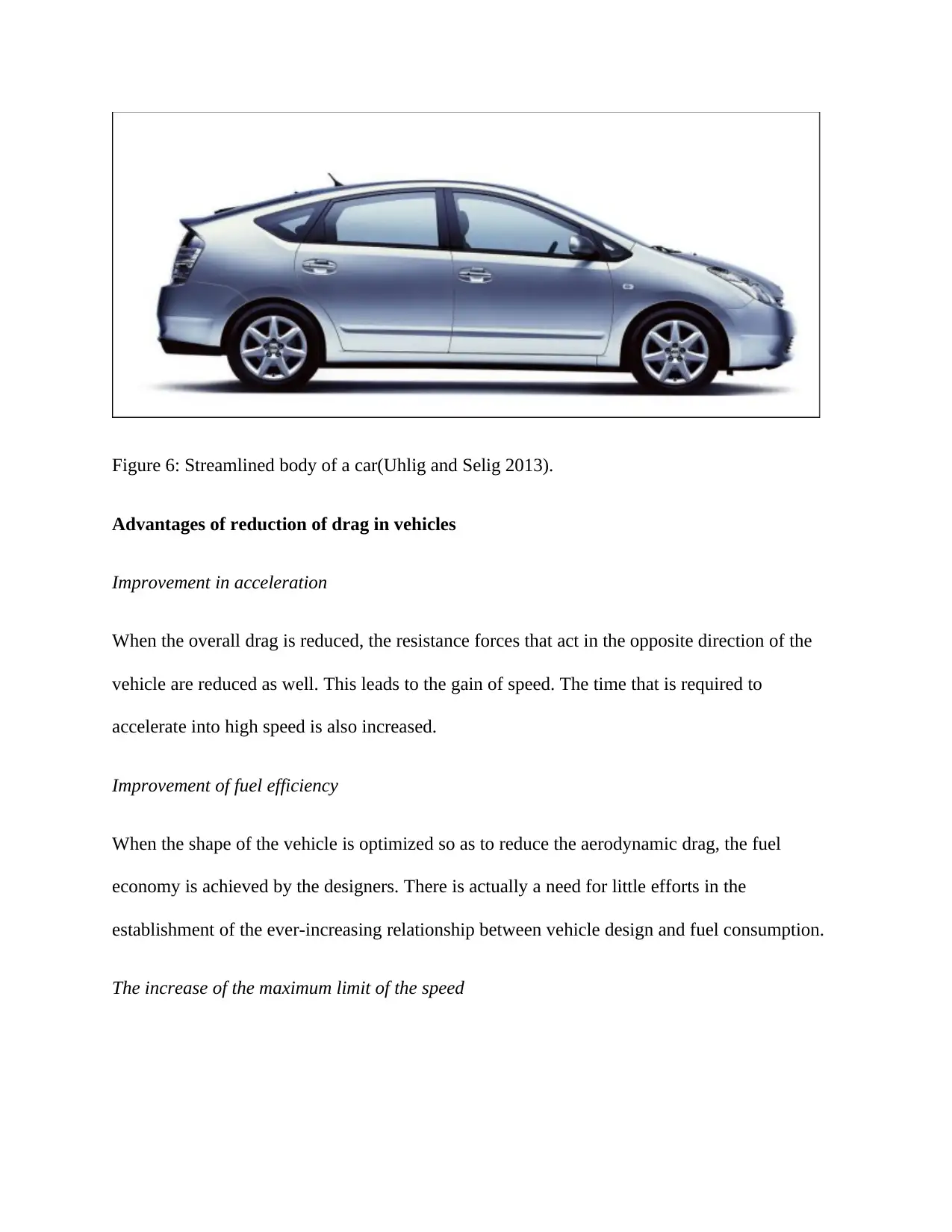
Figure 6: Streamlined body of a car(Uhlig and Selig 2013).
Advantages of reduction of drag in vehicles
Improvement in acceleration
When the overall drag is reduced, the resistance forces that act in the opposite direction of the
vehicle are reduced as well. This leads to the gain of speed. The time that is required to
accelerate into high speed is also increased.
Improvement of fuel efficiency
When the shape of the vehicle is optimized so as to reduce the aerodynamic drag, the fuel
economy is achieved by the designers. There is actually a need for little efforts in the
establishment of the ever-increasing relationship between vehicle design and fuel consumption.
The increase of the maximum limit of the speed
Advantages of reduction of drag in vehicles
Improvement in acceleration
When the overall drag is reduced, the resistance forces that act in the opposite direction of the
vehicle are reduced as well. This leads to the gain of speed. The time that is required to
accelerate into high speed is also increased.
Improvement of fuel efficiency
When the shape of the vehicle is optimized so as to reduce the aerodynamic drag, the fuel
economy is achieved by the designers. There is actually a need for little efforts in the
establishment of the ever-increasing relationship between vehicle design and fuel consumption.
The increase of the maximum limit of the speed
Paraphrase This Document
Need a fresh take? Get an instant paraphrase of this document with our AI Paraphraser
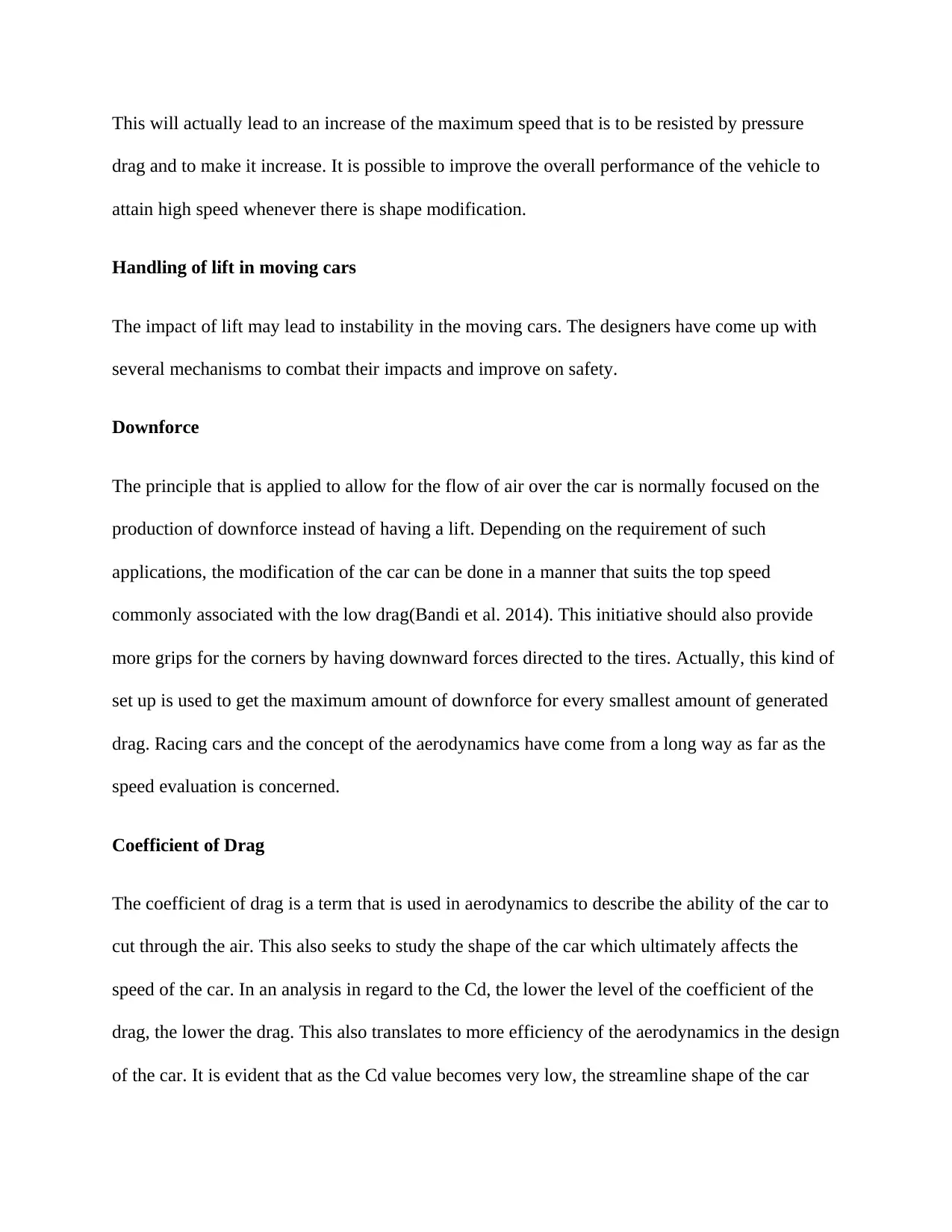
This will actually lead to an increase of the maximum speed that is to be resisted by pressure
drag and to make it increase. It is possible to improve the overall performance of the vehicle to
attain high speed whenever there is shape modification.
Handling of lift in moving cars
The impact of lift may lead to instability in the moving cars. The designers have come up with
several mechanisms to combat their impacts and improve on safety.
Downforce
The principle that is applied to allow for the flow of air over the car is normally focused on the
production of downforce instead of having a lift. Depending on the requirement of such
applications, the modification of the car can be done in a manner that suits the top speed
commonly associated with the low drag(Bandi et al. 2014). This initiative should also provide
more grips for the corners by having downward forces directed to the tires. Actually, this kind of
set up is used to get the maximum amount of downforce for every smallest amount of generated
drag. Racing cars and the concept of the aerodynamics have come from a long way as far as the
speed evaluation is concerned.
Coefficient of Drag
The coefficient of drag is a term that is used in aerodynamics to describe the ability of the car to
cut through the air. This also seeks to study the shape of the car which ultimately affects the
speed of the car. In an analysis in regard to the Cd, the lower the level of the coefficient of the
drag, the lower the drag. This also translates to more efficiency of the aerodynamics in the design
of the car. It is evident that as the Cd value becomes very low, the streamline shape of the car
drag and to make it increase. It is possible to improve the overall performance of the vehicle to
attain high speed whenever there is shape modification.
Handling of lift in moving cars
The impact of lift may lead to instability in the moving cars. The designers have come up with
several mechanisms to combat their impacts and improve on safety.
Downforce
The principle that is applied to allow for the flow of air over the car is normally focused on the
production of downforce instead of having a lift. Depending on the requirement of such
applications, the modification of the car can be done in a manner that suits the top speed
commonly associated with the low drag(Bandi et al. 2014). This initiative should also provide
more grips for the corners by having downward forces directed to the tires. Actually, this kind of
set up is used to get the maximum amount of downforce for every smallest amount of generated
drag. Racing cars and the concept of the aerodynamics have come from a long way as far as the
speed evaluation is concerned.
Coefficient of Drag
The coefficient of drag is a term that is used in aerodynamics to describe the ability of the car to
cut through the air. This also seeks to study the shape of the car which ultimately affects the
speed of the car. In an analysis in regard to the Cd, the lower the level of the coefficient of the
drag, the lower the drag. This also translates to more efficiency of the aerodynamics in the design
of the car. It is evident that as the Cd value becomes very low, the streamline shape of the car
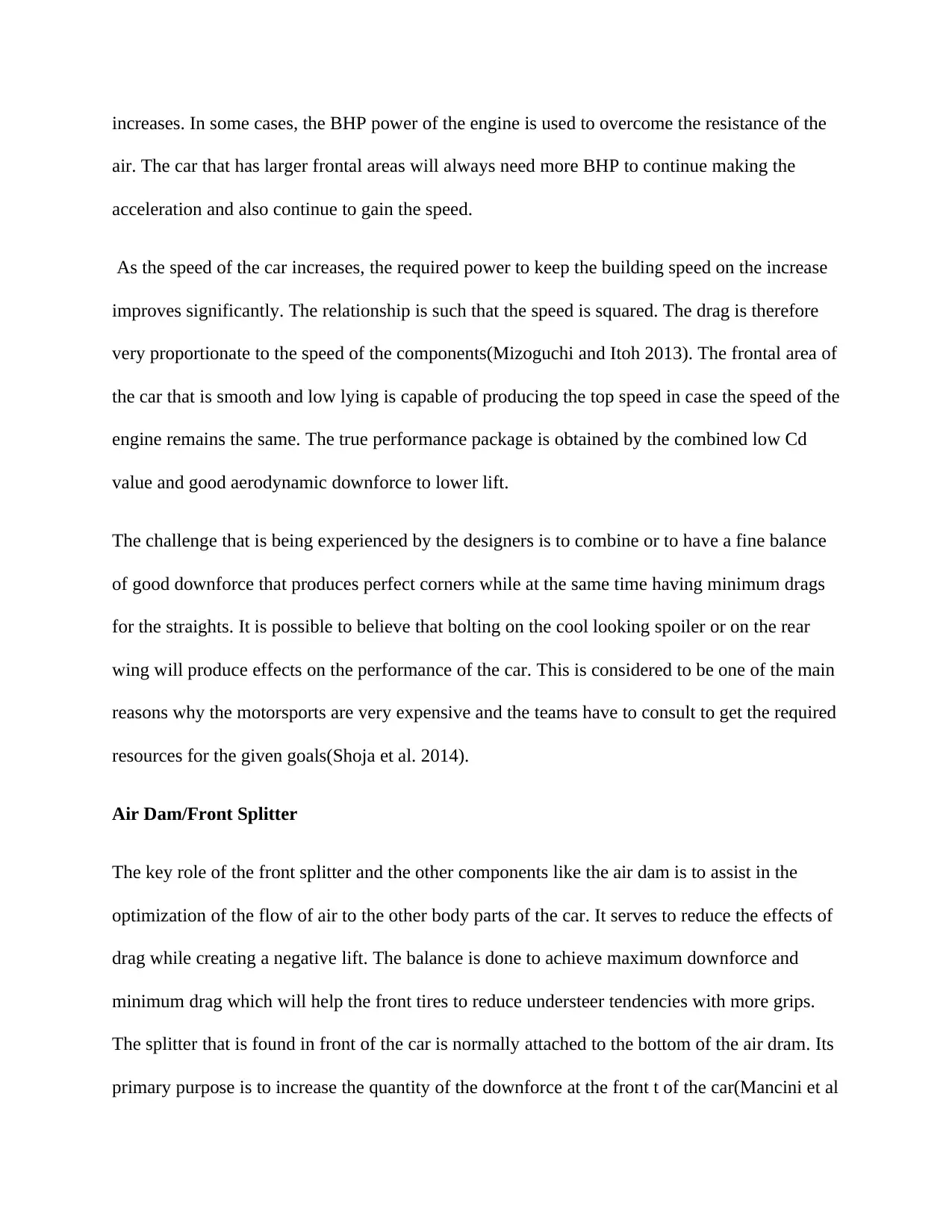
increases. In some cases, the BHP power of the engine is used to overcome the resistance of the
air. The car that has larger frontal areas will always need more BHP to continue making the
acceleration and also continue to gain the speed.
As the speed of the car increases, the required power to keep the building speed on the increase
improves significantly. The relationship is such that the speed is squared. The drag is therefore
very proportionate to the speed of the components(Mizoguchi and Itoh 2013). The frontal area of
the car that is smooth and low lying is capable of producing the top speed in case the speed of the
engine remains the same. The true performance package is obtained by the combined low Cd
value and good aerodynamic downforce to lower lift.
The challenge that is being experienced by the designers is to combine or to have a fine balance
of good downforce that produces perfect corners while at the same time having minimum drags
for the straights. It is possible to believe that bolting on the cool looking spoiler or on the rear
wing will produce effects on the performance of the car. This is considered to be one of the main
reasons why the motorsports are very expensive and the teams have to consult to get the required
resources for the given goals(Shoja et al. 2014).
Air Dam/Front Splitter
The key role of the front splitter and the other components like the air dam is to assist in the
optimization of the flow of air to the other body parts of the car. It serves to reduce the effects of
drag while creating a negative lift. The balance is done to achieve maximum downforce and
minimum drag which will help the front tires to reduce understeer tendencies with more grips.
The splitter that is found in front of the car is normally attached to the bottom of the air dram. Its
primary purpose is to increase the quantity of the downforce at the front t of the car(Mancini et al
air. The car that has larger frontal areas will always need more BHP to continue making the
acceleration and also continue to gain the speed.
As the speed of the car increases, the required power to keep the building speed on the increase
improves significantly. The relationship is such that the speed is squared. The drag is therefore
very proportionate to the speed of the components(Mizoguchi and Itoh 2013). The frontal area of
the car that is smooth and low lying is capable of producing the top speed in case the speed of the
engine remains the same. The true performance package is obtained by the combined low Cd
value and good aerodynamic downforce to lower lift.
The challenge that is being experienced by the designers is to combine or to have a fine balance
of good downforce that produces perfect corners while at the same time having minimum drags
for the straights. It is possible to believe that bolting on the cool looking spoiler or on the rear
wing will produce effects on the performance of the car. This is considered to be one of the main
reasons why the motorsports are very expensive and the teams have to consult to get the required
resources for the given goals(Shoja et al. 2014).
Air Dam/Front Splitter
The key role of the front splitter and the other components like the air dam is to assist in the
optimization of the flow of air to the other body parts of the car. It serves to reduce the effects of
drag while creating a negative lift. The balance is done to achieve maximum downforce and
minimum drag which will help the front tires to reduce understeer tendencies with more grips.
The splitter that is found in front of the car is normally attached to the bottom of the air dram. Its
primary purpose is to increase the quantity of the downforce at the front t of the car(Mancini et al
⊘ This is a preview!⊘
Do you want full access?
Subscribe today to unlock all pages.

Trusted by 1+ million students worldwide
1 out of 19
Related Documents
Your All-in-One AI-Powered Toolkit for Academic Success.
+13062052269
info@desklib.com
Available 24*7 on WhatsApp / Email
![[object Object]](/_next/static/media/star-bottom.7253800d.svg)
Unlock your academic potential
Copyright © 2020–2025 A2Z Services. All Rights Reserved. Developed and managed by ZUCOL.



